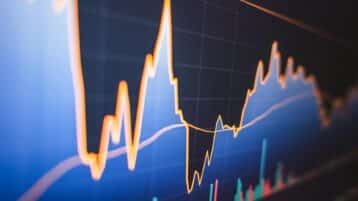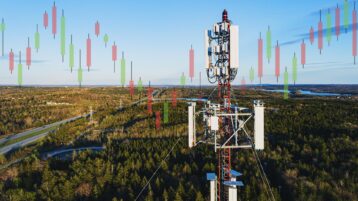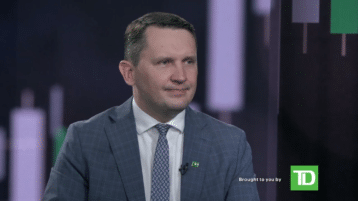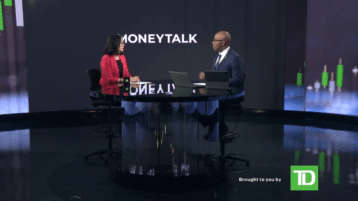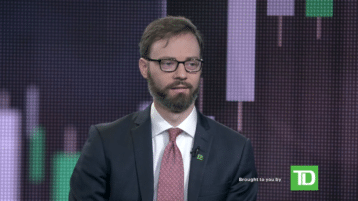The U.S. Federal Reserve delivered a quarter-point hike in an effort to tamp down on inflation, and signaled further increases at upcoming meetings. Anthony Okolie speaks with James Marple, Senior Economist at TD, about the outlook for rates and the U.S. economy.
Print Transcript
[AUDIO LOGO]
As expected, the Fed hiked rates another 25 basis points. I think it's the highest level in 16 years. But they also signaled more rate hikes to come. James, did anything surprise you, or is this just another case of deja vu?
Yeah, nothing really surprising in this statement. They continue to say that they expect to raise interest rates. So that was the one area where we were looking to see, do they sort of say-- like the Bank of Canada has, that they think they've done now over 400, and maybe we're close to the end. They didn't really change that statement. So they're sticking to their guns that they will continue to raise interest rates from here. If anything, that was the only piece of uncertainty in the statement itself.
OK, so you mentioned that they could be hiking interest rates-- more interest rate hikes to come. How much further do you think the Fed will go before it pauses on rate hikes? Because we've heard from some Fed officials in the past, who were very hawkish-- they're saying that the Fed should hike rates as much as 5% in order to tamp down inflation. So how high do you think the Fed will have to hike?
Yeah, well, they got to the top range of 4.75%. Now, we think 25 more in hikes is to come, probably at their next meeting in March. That will take them to that 5% mark. At that point, I think they do pause and reassess how the economy is doing. I mean, we are seeing signs that inflation is slowing. Certainly, the headline on lower energy prices, but even core measures starting to come down, and that's a positive signal.
We've obviously also seen the impact in interest rate-sensitive sectors of the economy like housing. And overall economic activity is not growing swiftly. So I think a lot of those indicators, we don't have any signs of an immediate recession, but certainly enough that we think the Fed could pause and take stock of the impact so far.
OK. Now, I want to talk a little bit about the bond markets because, certainly, we've seen some divergence in the past between the bond market and what the Fed is saying. How have bond markets reacted? And what are the yield curves telling investors about the economy and the potential for recession this year?
Sure. Well, it was interesting watching it as the statement came out. You saw some move at the front end of the curve. The two year moved up a little bit, and the longer end of the curve moved down. Once the Fed Chair started speaking, though, we saw, actually, rallying at all parts of the curve, even the two year starting to come down. So obviously his statement treated as a little more dovish than the statement itself.
But we didn't see a lot of moves. I think a lot of this was very highly anticipated, so not surprising that that already priced in to the bond market. But what you do see is that the long end of the curve, the 10 year especially, is well below the short end. So you have a 3 and 1/2% or so at the 10 year end, closer to 4% on the two year, which is just below where the Fed funds rate is right now. That's a pretty deeply inverted yield curve. And that signals that bond investors do expect, eventually, interest rates to start falling. That's not too surprising. The Fed has moved well beyond what they even consider neutral. But typically, when you have the long end of the curve below the short end, it signals some concern about future economic growth and some potential risk of a downturn.
And what other potential risks do you see to the Fed's outlook?
Sure. Well, I think we're really looking at the labor market quite closely. So even as we've seen signs of slowing in housing, and even leading indicators like manufacturing-- the Purchasing Managers' Index data that came out this week was in contractionary territory-- we've still seen this resilience in the labor market. We had job openings that moved up to a record high and a pace of job growth that's still running well above what we think it should be, just to keep the unemployment rate constant.
So I think a lot of the attention and the risks are going to be to the labor market. And if we start to see signs of that slowing at a nice pace, that would be great. That's a good sign that we could see a soft landing. But there, I think, if we see continued strength, it means probably more in the way of rate hikes. And if we see it start to slow really dramatically, well, that's a good leading indicator that the economy's going to turn down.
So you talked about the labor market. Are there any other indicators that you'll be watching as the Fed considers its next move?
Yeah. Well, certainly, the labor market. I mean, the inflation-- in the inflation data, as we saw mentioned, I mean, we've seen good evidence that goods prices are coming down, some of the supply chain issues having been resolved. Demand for goods has fallen, some of that interest rate sensitive, but also just as activity normalizes after the pandemic.
The housing inflation data is also important to watch. And we've seen new leases start to come down, that should show up in future inflation. But I think, really, it's going to be wages and what happens in the remainder of the economy. And if we see that starting to slow, I think that would give the Fed the confidence that they really are seeing inflation move toward their 2% target.
OK, now I want to finish off by talking about the US dollar, which has weakened a little bit against a basket of major currencies. Where do you see the US dollar going after this latest acknowledgment by the fact that there are more rate hikes to come?
Well, if you'd asked me in December when the dollar was at its peak, I would have said it's going to weaken. But now we've seen some of that actually come to fruition. And I think the level of the dollar against, for example, the Canadian dollar or even the Euro is-- it's weakened a fair bit. So I don't think we're going to see much more in the way of weakening now.
If anything, could go back the other way if the Fed continues to stick to its guns and we see any signs of economic weakness, namely in Europe, where there's been some positive attitudes just because we haven't seen a real recession as was expected. And the weather's been good. But there's a lot of risks there. So I would say not very much movement from where it is today. But if anything, perhaps some strengthening in the very near term. [AUDIO LOGO]
[MUSIC PLAYING]
As expected, the Fed hiked rates another 25 basis points. I think it's the highest level in 16 years. But they also signaled more rate hikes to come. James, did anything surprise you, or is this just another case of deja vu?
Yeah, nothing really surprising in this statement. They continue to say that they expect to raise interest rates. So that was the one area where we were looking to see, do they sort of say-- like the Bank of Canada has, that they think they've done now over 400, and maybe we're close to the end. They didn't really change that statement. So they're sticking to their guns that they will continue to raise interest rates from here. If anything, that was the only piece of uncertainty in the statement itself.
OK, so you mentioned that they could be hiking interest rates-- more interest rate hikes to come. How much further do you think the Fed will go before it pauses on rate hikes? Because we've heard from some Fed officials in the past, who were very hawkish-- they're saying that the Fed should hike rates as much as 5% in order to tamp down inflation. So how high do you think the Fed will have to hike?
Yeah, well, they got to the top range of 4.75%. Now, we think 25 more in hikes is to come, probably at their next meeting in March. That will take them to that 5% mark. At that point, I think they do pause and reassess how the economy is doing. I mean, we are seeing signs that inflation is slowing. Certainly, the headline on lower energy prices, but even core measures starting to come down, and that's a positive signal.
We've obviously also seen the impact in interest rate-sensitive sectors of the economy like housing. And overall economic activity is not growing swiftly. So I think a lot of those indicators, we don't have any signs of an immediate recession, but certainly enough that we think the Fed could pause and take stock of the impact so far.
OK. Now, I want to talk a little bit about the bond markets because, certainly, we've seen some divergence in the past between the bond market and what the Fed is saying. How have bond markets reacted? And what are the yield curves telling investors about the economy and the potential for recession this year?
Sure. Well, it was interesting watching it as the statement came out. You saw some move at the front end of the curve. The two year moved up a little bit, and the longer end of the curve moved down. Once the Fed Chair started speaking, though, we saw, actually, rallying at all parts of the curve, even the two year starting to come down. So obviously his statement treated as a little more dovish than the statement itself.
But we didn't see a lot of moves. I think a lot of this was very highly anticipated, so not surprising that that already priced in to the bond market. But what you do see is that the long end of the curve, the 10 year especially, is well below the short end. So you have a 3 and 1/2% or so at the 10 year end, closer to 4% on the two year, which is just below where the Fed funds rate is right now. That's a pretty deeply inverted yield curve. And that signals that bond investors do expect, eventually, interest rates to start falling. That's not too surprising. The Fed has moved well beyond what they even consider neutral. But typically, when you have the long end of the curve below the short end, it signals some concern about future economic growth and some potential risk of a downturn.
And what other potential risks do you see to the Fed's outlook?
Sure. Well, I think we're really looking at the labor market quite closely. So even as we've seen signs of slowing in housing, and even leading indicators like manufacturing-- the Purchasing Managers' Index data that came out this week was in contractionary territory-- we've still seen this resilience in the labor market. We had job openings that moved up to a record high and a pace of job growth that's still running well above what we think it should be, just to keep the unemployment rate constant.
So I think a lot of the attention and the risks are going to be to the labor market. And if we start to see signs of that slowing at a nice pace, that would be great. That's a good sign that we could see a soft landing. But there, I think, if we see continued strength, it means probably more in the way of rate hikes. And if we see it start to slow really dramatically, well, that's a good leading indicator that the economy's going to turn down.
So you talked about the labor market. Are there any other indicators that you'll be watching as the Fed considers its next move?
Yeah. Well, certainly, the labor market. I mean, the inflation-- in the inflation data, as we saw mentioned, I mean, we've seen good evidence that goods prices are coming down, some of the supply chain issues having been resolved. Demand for goods has fallen, some of that interest rate sensitive, but also just as activity normalizes after the pandemic.
The housing inflation data is also important to watch. And we've seen new leases start to come down, that should show up in future inflation. But I think, really, it's going to be wages and what happens in the remainder of the economy. And if we see that starting to slow, I think that would give the Fed the confidence that they really are seeing inflation move toward their 2% target.
OK, now I want to finish off by talking about the US dollar, which has weakened a little bit against a basket of major currencies. Where do you see the US dollar going after this latest acknowledgment by the fact that there are more rate hikes to come?
Well, if you'd asked me in December when the dollar was at its peak, I would have said it's going to weaken. But now we've seen some of that actually come to fruition. And I think the level of the dollar against, for example, the Canadian dollar or even the Euro is-- it's weakened a fair bit. So I don't think we're going to see much more in the way of weakening now.
If anything, could go back the other way if the Fed continues to stick to its guns and we see any signs of economic weakness, namely in Europe, where there's been some positive attitudes just because we haven't seen a real recession as was expected. And the weather's been good. But there's a lot of risks there. So I would say not very much movement from where it is today. But if anything, perhaps some strengthening in the very near term. [AUDIO LOGO]
[MUSIC PLAYING]





